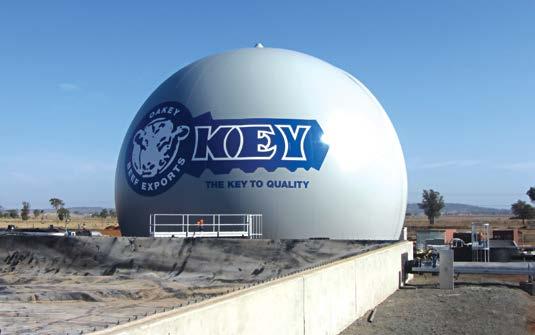
17 minute read
Electric Vehicles
ABB and Volvo to electrify Gothenburg’s city streets
Starting in 2020, 157 new Volvo electric buses will start operating on the streets of Gothenburg, Mölndal and Partille in Sweden, powered by charging infrastructure solutions from market leading provider, ABB. This landmark announcement represents an important step towards achieving a sustainable public transport solution for the 180 million trips made by bus in the region each year.
Advertisement
In line with the Swedish government’s vision that Sweden should be climate neutral by 2050, public transport company Västtrafik expects to have electrified all city traffic in Västra Götaland by 2030.
Volvo Buses and ABB are helping to realize that aim with the supply of 157 new electric buses and supporting charging infrastructure to bus operator Transdev.
With services scheduled to commence in December 2020, the new electrified lines will mean a total of 220 electric buses to transport Gothenburg's residents and visitors by the end of the year.
“Volvo Buses is a leader in electromobility and solutions for sustainable public transport. Together with ABB and our partners, we have created a common holistic transport solution that will make public transport in Gothenburg quieter and emission-free”, says Håkan Agnevall, President, Volvo Buses.
“The solution shows that electric buses are not only something for the future, but already today provide cities with public transport that is sustainable and financially viable,” Mr Agnevall added. 19 new high-power electric chargers will be installed during the second half of 2020 before the new buses go into operation, and another two stations are planned for the future.
The buses in Gothenburg, Mölndal and Partille will be charged by 450kW high power Panto Down chargers from ABB. A modular solution based on OppCharge, an open interface for direct current (DC) electric bus charging, the solution offers high-power charging via an automated rooftop connection. ABB will supply a complete solution that includes both the charging stations and all the necessary grid connection hardware via ABB’s cable distribution cabinets.
The buses will be recharged in just three to six minutes at charging stations along the routes. The high-power chargers, a part of ABB’s innovative ABB Ability™ offering of digital solutions and services across all business areas, delivers web-enabled connectivity that allows network operators to perform remote monitoring and configuration of charge points and also minimises downtime and increases efficiency.
“The sustainable transformation of bus traffic in Gothenburg is an example of how ABB is pursuing its Mission to Zero, with the goal to develop innovations that will contribute to a zero-emission future. We have the products and solutions to deliver electricity from generation to the point of consumption in a safe, smart and sustainable way”, says Frank Muehlon, Head of ABB’s global business for E-mobility Infrastructure Solutions.
With room for 150 passengers and an 88 percent reduction in CO 2 when transitioning to electricity, the new buses combine high passenger capacity with low environmental footprint.
ABB is a world leader in electric vehicle infrastructure, offering the full range of charging and electrification solutions for electric cars, electric and hybrid buses as well as for ships and railways. ABB entered the EV-charging market back in 2010, and today has sold more than 13,000 ABB DC fast chargers across over 80 countries. ABB recently received the Global E-mobility Leader 2019 award for its role in supporting the international adoption of sustainable transport solutions.
ABB offers products and services that provide a crucial contribution to increased sustainability in industry. More than half of ABB worldwide sales are generated with technology that contributes to the elimination of the causes of climate change. It is the goal of ABB within the scope of Mission to Zero to increase the sales share of solutions and systems for increased sustainability to 60 percent by the end of 2020.
ABOUT ABB ABB is a technology leader that is driving the digital transformation of industries. With a history of innovation spanning more than 130 years, ABB has four customerfocused, globally leading businesses: Electrification, Industrial Automation, Motion, and Robotics & Discrete Automation, supported by the ABB Ability™ digital platform. ABB’s Power Grids business will be divested to Hitachi in 2020. ABB operates in more than 100 countries with about 147,000 employees. For further information, please visit: www.abb.com
Global electric car count climbs from 5.6 To 7.9 million

The number of electric cars on the road worldwide had risen to around 7.9 million in 2019, an increase of 2.3 million from the previous year. The number of new registrations again reached a record high, but the growth rate was just slightly up compared to 2018.
China remains the undisputed global leader with 3.8 million e-cars. It is followed by the USA with nearly 1.5 million cars. The growth rate for new registrations dipped in these two countries.
In Germany, by contrast, the market remained on its positive trajectory, even if the growth curve was not quite as steep. Nearly 231,000 electric vehicles were on German roads at the end of 2019.
These new figures are sourced from a recent survey conducted by the Centre for Solar Energy and Hydrogen Research BadenWürttemberg (ZSW). According to its scientists, Tesla accounted for the largest share of new registrations worldwide in 2019 with 361,000 vehicles. German automakers again improved on the previous year’s showing. BMW is in fifth place worldwide with 114,500 electric cars. VW took sixth place.
New registrations reached a record high in 2019 at 2.3 million vehicles worldwide. However, the global growth rate was just four percent, compared to 74 percent in the previous year. This development is largely attributable to the reduced subsidies for battery-powered vehicles in China and the USA. Even so, the number of new registrations in these countries approached the previous year’s marks with 1,204,000 in China, down 52,000 from the previous year, and 329,500 in the USA, down 31,800 from 2018.
Germany bucked the international trend as the number of new registrations continued to rise, topping last year’s 24 percent growth rate with 61 percent this year. The country is now third worldwide with 108,600 newly registered electric cars, moving up one place from last year’s showing. Norway follows in fourth place with 81,540 newly registered vehicles.
A different picture emerges when it comes to e-vehicles’ share of total new passenger car registrations. More than one of every two new passenger cars in Norway is electric. This 57-percent share is the largest worldwide. By comparison, electric cars account for only three percent of new registrations in Germany, five percent in China and two percent in the USA.
Norway follows on the heels of China and the USA, taking third place with 370,800 electric vehicles in total. Japan is in fourth place with around 300,000 cars, followed by France with 274,100 and the United Kingdom with 235,700. Germany is in seventh place with 230,700 electric vehicles, which is one step up from the previous year’s placing.
“Although the growth rate for newly registered electric vehicles is relatively high in Germany, the market continues to lag behind,” says Prof. Frithjof Staiß, Managing Director of the ZSW. “This development will have to pick up a lot more momentum to reach the German government’s goal of seven to ten million electric vehicles by 2030.”
Tesla is in the lead in terms of cumulative new registrations with over 875,000 e-cars. Chinese automakers BYD and BAIC follow in second and third place with around 737,000 and 480,000, respectively. Two German companies took fifth and sixth place – BMW with 398,000 cars and VW with 351,000.
Tesla is also the undisputed leader in 2019 with 361,000 newly registered cars, followed by the three Chinese companies BYD (219,000), BAIC (158,000) and SAIC (126,000). BMW and VW are also ranked fifth (115,000) and sixth (93,000) in this category. The gap to the global leaders is considerable: Tesla accounts for far more new vehicle registrations than BMW and VW combined.
TESLA ALSO IN THE LEAD WITH 2019 MODELS Tesla’s Model 3 took the top position in cumulative new registrations with 445,000 vehicles despite being on the market for less than three years. The Nissan Leaf and Tesla Model S, last year’s most frequently registered models, follow with 434,000 and 281,000, respectively. The only German model in the top ten in terms of cumulative new registrations is the BMW i3 with over 155,000 registrations.
Tesla’s Model 3 is also clearly ahead in 2019’s statistics with 297,000 new registrations. Its lead over the runners-up is considerable with the BAIC EU Series accounting for 111,000 and the BYD Yuan for 68,000 new registrations. BMW 5 Series plug-in hybrids achieved the best German result, taking sixth place with 46,000 models sold. The fact that seven of the top ten newly registered vehicles are purely batterypowered merits special mention.
Narrowing the focus to the German market, the statistics for new car registrations have little in common with the global figures. The Renault Zoe defended its first-place ranking with 9,430 cars sold. The BMW i3 was a very a close second with 9,380 cars, a total that includes both the battery-powered electric model and the version with a range extender. It edged out the Tesla Model 3 with 9,010 cars.
“The odd success notwithstanding, the numbers show that German automakers have to step up their efforts on a much broader scale to keep up with the world leaders,” says Staiß. “It is crucial for the German automotive industry that its upcoming e-models achieve market success.”
This could also spare German carmakers billions of euros in fines. As of 2021, there will be stiff penalties to pay if the averaged CO2 emissions for the entire fleet of vehicles sold exceeds regulatory targets. These funds could then be put to better use for investing and creating value in Germany – for example, with in-house battery cell production capabilities. available on a global scale. This is why the authors based their analysis of newly registered makes and models on data sourced from the 18 largest markets for e-vehicles. ZSW’s figures represent a conservative assessment of actual developments. The paucity of globally available data that distinguishes among registered electric cars by their make and model prompted the authors to use the phrase “cumulative new registrations” for these figures.
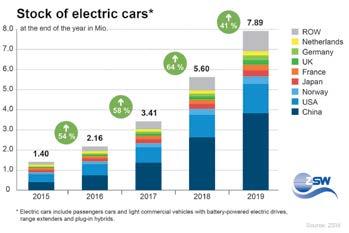

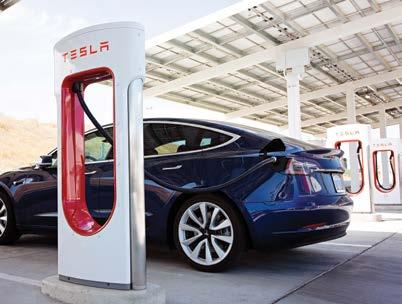
THE BASELINE – VEHICLES RECHARGED WITH ELECTRICAL POWER The report encompasses only those passenger cars and light commercial vehicles with battery-powered electric drives, range extenders and plug-in hybrids – that is, all vehicles that are charged externally with electrical power. It does not factor in full hybrid vehicles that can cover shorter distances with a relatively small battery, but cannot be charged externally; nor does it include mild hybrids and vehicles equipped with fuel cells. This assessment is based on data from the German Federal Motor Transport Authority, government agencies and NGOs abroad, and other sources.
The authors of this report were able to ascertain the number of previously and newly registered electric vehicles in countries worldwide. However, data on specific makes and models is not
ABOUT ZSW The Zentrum für Sonnenenergie- und Wasserstoff-Forschung Baden-Württemberg (Centre for Solar Energy and Hydrogen Research Baden-Württemberg, ZSW) is one of the leading institutes for applied research in the areas of photovoltaics, renewable fuels, battery technology, fuel cells and energy system analysis. There are currently around 280 scientists, engineers and technicians employed at ZSW’s three locations in Stuttgart, Ulm and Widderstall. In addition, there are 100 research and student assistants.
Roadmap needed to integrate electric vehicles into Australia’s energy market
The Australian Energy Market Commission (AEMC) says Australia needs a forward-thinking plan to get the energy system ‘market ready’ for an electric vehicle future. In a new issues paper released recently as part of its 2020 retail energy competition review, the Commission says planning ahead for the boost in energy use from electric vehicles will ensure this new technology has a positive impact on the energy market.
“Electric vehicles will boost demand for electricity and could have a big impact on the energy market,” said Commission Acting Chief Executive Suzanne Falvi.
“Sales of electric vehicles increased by more than 200% between 2018 and 2019 and we need to lock in lower cost ways to support consumers who want them. If we get ahead of the curve, we can make sure this technology makes a positive contribution to our future power system and doesn’t become another cost driver.”
“We’re starting a conversation with this issues paper to generate ideas and identify what barriers to innovation there might be that could stop new electric vehicle products and services reaching consumers,” Ms Falvi added.
The Commission’s issues paper gives public charging stations as one example of how electric vehicles can have a large impact on the grid. One charging station built in Adelaide in 2017 with eight chargers was equivalent to the connection of 100 new homes. The paper also says that while electric vehicles have an obvious value as a mode of clean transport, they could also benefit the market by promoting more efficient use of the infrastructure we already have.

“Electric vehicles have potential to put energy power back in the hands of consumers and help keep the system reliable and secure,” Ms Falvi said.
“With the right systems in place, households can charge their vehicles when energy is cheap and have the option to sell power back into the grid when it’s more expensive. Along with solar PV and smart appliances, electric vehicles can be part of a consumer’s future toolkit to reduce their energy output when prices are high.”
The AEMC issues paper says digitalisation will see smart and flexible charging systems benefitting consumers without any conscious effort. It also says that if given the right market signals, electric vehicle charging load could provide a significant demand response resource for the system.
In California for example, Enel X is aggregating electric vehicle charging loads, providing a 30MW/70MWh resource in energy markets. This ‘virtual battery’ of more than 6,000 chargers can ramp up and down to meet energy market needs, with customers involved receiving incentives.
Technology developments might also mean greater potential for households to use electric vehicle batteries ‘behind the meter’ to soak up excess rooftop solar generation and then discharge electricity to their own home or to the grid. But so far, limited uptake of electric vehicles means there aren’t many retail products targeting this market.
“Electric vehicles are an opportunity for retailers or new energy providers to innovate with new residential products,” Ms Falvi said. “While existing consumer protections must apply to new products and services, we need to make sure that existing rules and regulations don’t stifle innovation.”
The Commission wants to know what products and services are being developed, both for residential and public charging - for example, in workplaces, shopping centres and car parks. It also wants to know whether retail market competition is resulting in innovation in this space.
In asking stakeholders for feedback, the Commission is considering whether any existing retail regulation is creating barriers to electric vehicle use.
ELECTRIC VEHICLES: FAST FACTS • Nearly 8 million sold worldwide to date • More than 6,700 sold in Australia in 2019 • 22 models currently available and nine more expected in 2020 • 1930 public vehicle charging stations in Australia as of July 2019 – a 140% increase in the year to July 2019 • 70% of vehicle owners are likely to have access to dedicated charging stations at home or work
ABOUT THE AEMC The Australian Energy Market Commission (AEMC) is the rule maker, market developer and expert adviser to governments on energy. It protects consumers and achieves the right tradeoff between cost, reliability and security.
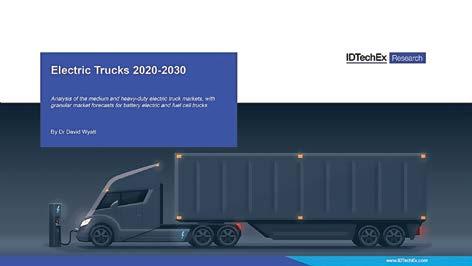
IDTechEx Technology Analyst Dr David Wyatt has recently published a report update “Electric Trucks 2020-2030”, focusing on electrification in the medium and heavy-duty truck markets, providing a comprehensive set of market forecasts.
Along with the rest of the automotive sector, the medium and heavy-duty truck market is evolving. Governments around the world, recognising the potentially catastrophic repercussions of unfettered climate change and witnessing the detrimental impact on human health from vehicle exhaust pollutant emissions in urban environments, are taking decisive action, that will, in the coming decades, drive vehicle manufacturers to zero on-road exhaust emission powertrain solutions. Consequently, many believe that the days of the fossil fuelpowered combustion engine are numbered.
In the face of tightening CO 2 emission legislation for new trucks, that will be difficult to meet in the relatively near future with a fossil fuel combustion engine, and increasing pressure to limit peoples exposure to hazardous air pollutants in city centres, that are in large part the result of on-road transportation, a much cleaner source of power is required for future medium and heavy-duty trucks. This need is compounded by increasing demand for freight delivery as the retail industry grows its online sales platforms and people gradually abandon private car ownership for mobility as a service (MaaS) platforms.
It is already clear that it is impossible for ICE-powered fuel efficiency improvements to deliver the required emission reductions in the long-term. The future is either batteryelectric or fuel cell electric vehicles. They deliver a zero on-road emission solution, that immediately protects people from PM and NOx emissions in urban areas and passes the burden of decarbonisation from vehicle manufacturers on to the generators of electricity.
Diesel and petrol combustion engines are already a technology of the past, prudent companies in the automotive industry are already transitioning themselves toward the electric and fuel cell supply chain. All major truck OEMS are now investing in zeroemission trucks projects for fear of being left behind.
The IDTechEx “Electric Trucks 2020-2030” report is intended to help businesses across the automotive value chain plan for the future in this rapidly changing market. The report provides 48 forecast lines for battery electric and fuel cell electric trucks, that include a ten-year outlook for vehicle production, market penetration and market value, with separate forecasts for both the medium and heavy-duty truck markets and regional segmentation for China, North America, Europe and ROW.
An up-to-date overview of the battery and fuel cell electric truck market is provided in the report, with detail about current demonstration projects and efforts by major players in the industry to commercialise zero-emission trucks, across each of the key regions.
The report presents background to technology development in the electric truck market, including fuel cells and electric hybridization, along with a discussion of key enabling technologies for electric truck deployment such as batteries, motors and charging infrastructure.
Red Energy charges into the EV space
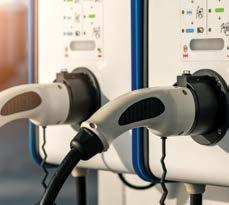
Red Energy announced recently announced that it will offer Electric Vehicle owners electricity every weekend to charge their cars with free usage charges.
In a new product offering to electric vehicle owners, Red will provide electricity between 12 noon and 2pm every Saturday and Sunday with free electricity usage charges. The Red EV Saver will also include Red’s renewable matching promise. This provides customers with a guarantee that for every unit of electricity they use, Snowy Hydro will match it by generating one unit from a renewable source.
“We are a business that’s owned and powered by one of Australia’s leaders in renewable energy, Snowy Hydro” said Iain Graham, CEO of Red Energy. “This product is supported by Red’s renewable matching promise. We know renewables are important to electric vehicle owners which is why we think Red’s offer will appeal to these customers”.
Charging an electric vehicle is estimated to add approximately 35% to an average customer’s annual consumption. Red Energy’s offer will minimise the cost of “fuel” for the customer. Customers require a smart meter or an interval meter. Red Energy can assist with the installation of a smart meter if they don’t have one.
Red Energy has three electric vehicles in its company fleet and has plans to install a charging station at its Richmond Contact Centre in Melbourne.
For more information, please visit: www.redenergy.com.au



